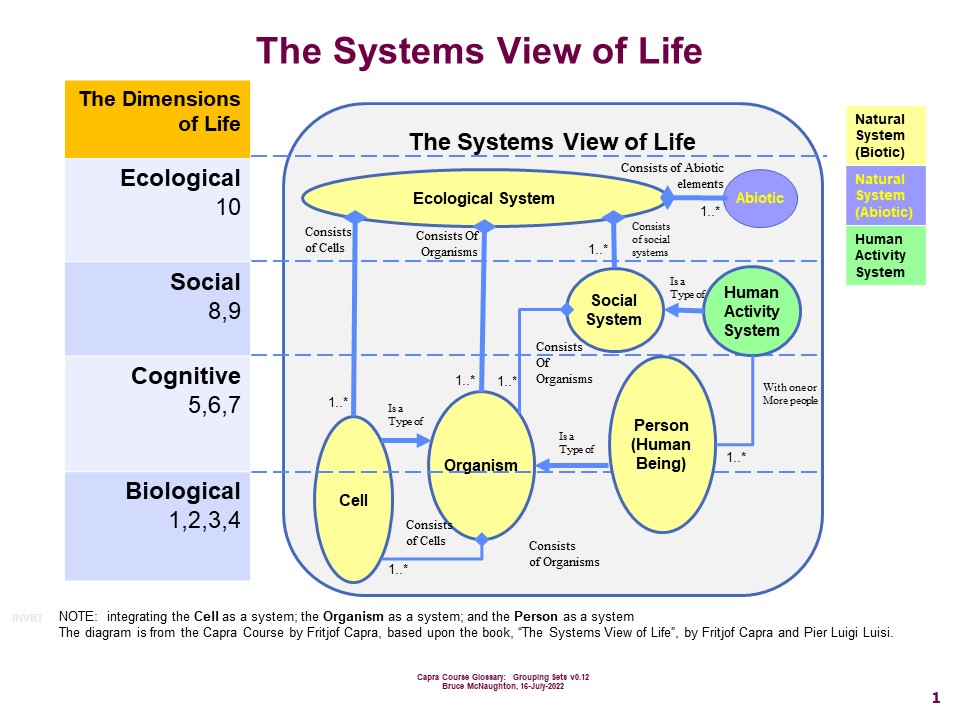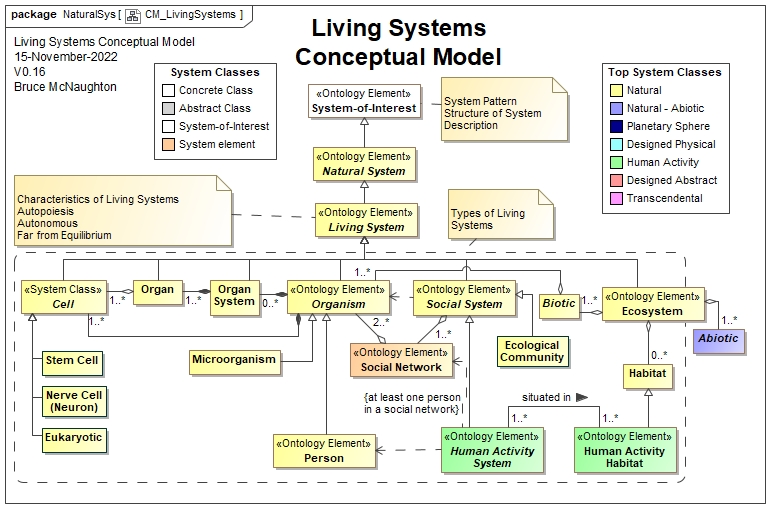Living Social System
A living social system provides its members a way to achieve a purpose that no member can accomplish on their own.
The living social system consists of the following elements:
- Social Network
- Social Structure
- Emergent Culture
The members of the social system are typically organisms (e.g. bees, ants, human beings, bacteria, etc.). A human activity system is a type of social system where the members are predominately human beings (people / person). Aspects of human activity systems are also covered in this document.
This document provides a description of the systems and concepts used in a Social System within the set of Living Systems. This document describes the various elements of the Social System and how these relate to the various systems derived from this system type. The social system also integrates the Person (Human Being).
PDF:: System Description: Person (Human Being),
PDF:: System Description: Social System,
Background
This model of a Social System comes from the concepts included in the various books, lectures and movies that Fritjof Capra related to the systems view of life. The key sources for this paper come from the following sources:
- the textbook, The Systems View of Life. Specifically, sections 14.1 through 14.4.
- the 12 lectures in the Capra Course based upon the Systems View of Life, specifically lectures 5, 7, 8, and 9.
- the book, The Hidden Connections, providing additional information on social systems
- the book, Leadership and the New Science, by Margaret Wheatley
- the book, Organizational Culture and Leadership, by Edgar Schein
- and many other books related to social systems
The living systems addressed by the Capra Course and the Systems View of Life are shown in the next picture:

This System Description focuses on the Social System as a living system and highlights the social system as the basis for a Human Activity System (HAS), This diagram also highlights the relationship to other living systems.
The social system is a fundamental system type that forms the basis for all human activity systems, such as the Enterprise, Household, Government, Community of Practice, and Financial Institutions.
This document also builds upon the system concepts used to create the system descriptions used in this document. The links in each of the headings of a system description contain information about the system viewpoint.
Living Systems
The following diagram highlights the various types of living systems.

The Social System
This document describes the social system as a living system. A system description is provided for the social system along with various topics related to the various components (parts) and processes (the dynamics) of the social system. Communication is key to the aliveness of the organization.
The following conceptual model shows the position of the abstract social system model and its use to define human activity systems. Human Activity Systems are social systems that are predominately human beings (people / person) as members of a social network.

The Person
A person is a type of organism. The system description of a person is included in this document as many of the systemic properties of a person are needed to form a healthy living human activity system. Though any person in the human activity system can take on the role of a leader, the specific skills, knowledge and experience make this role much more effective. These aspects are covered in this document.
Notes
Many of the terms used in this document come from the new Capra Course Glossary and the associated mapping back to the system concepts used to create the system descriptions.
The social system model is a Fractal Model (self similar when applied).
Social System have capabilities and states that differentiate social systems in the following way:
- The difference between one social system and another is the set of capabilities (people, process and technology) they need to deliver their purpose.
- These capabilities relate to their contribution and fit within the social structure.
Social Systems are Networks of Networks within an organization
- All social systems are structurally coupled within an organization.
- Key linking of the organization is through the manager of a team as a social system. These managers are generally part of two social systems 1 as manager and 1 as team member.
Informal vs Formal Networks of communication
- In the conceptual model, there is only one social network of communications and one set of people (members).
- This network of communications can have conversations that are both formal and informal.
- Creating an open and trusting network of communication will align both the formal and the informal and value creativity and innovation to create emergence and adaptation.
- Aliveness arises from the coherence of the formal and informal networks of communication.